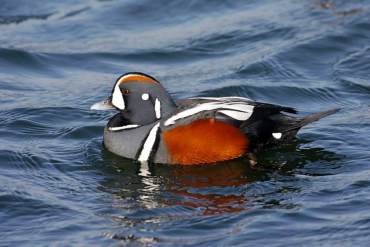
Western Washington’s ferryboat fleet provides two ways to enjoy fall birdwatching. Not only can you take a round-trip ride as a passenger to see different birds, you can bird around your favorite ferry terminal.
Several unique species hang out near these easily accessible docking areas. Just don’t forget the binoculars.
Kingston-Edmonds
This ferry crossing intersects a major migration route traveled by birds coming from the San Juan Islands and the Strait of Juan de Fuca. This route enters the inland waters of Puget Sound.
During the fall, large numbers of gulls, terns and phalaropes can be seen from the Kingston dock. Adding more color to the gathering are the pigeon guillemots who are year-round residents in the Sound. Along with cormorants and glaucous-winged gulls, they nest on the docks.
If you choose to bird from the ferry, it is an opportunity to get closer to birds feeding offshore. The red-necked phalarope, a bird that nests in the far north, travels in large flocks. These birds are classified as shorebirds but often feed near the middle of this northern ferry crossing.
Watch for small birds sitting on the water and spinning in circles. They’re stirring up the water with their feet while feeding on microscopic marine life.
Winslow-Seattle
It pays to walk the long ramp leading from the Winslow terminal to the boat and look out the open windows. Interesting birds can be seen in the water a short distance from the shore. When you can look down on birds, it’s a bonus and much easier than searching in the trees over your head.
Scoters, both white-winged and surf, feed in the water the ferry’s propellers churn nonstop. Bufflehead, Barrow’s goldeneye, other ducks and several grebe species also frequent the Eagle Harbor area. The huge ferry dolphins seem to have been created not only for the gulls to perch on but they are equally popular with cormorants.
If you bird this ferry crossing, watch for more cormorants on the buoy marker that is near the boat’s turn to the southeast. Three cormorant species use this spot while resting and drying their outstretched wings.
Bremerton-Seattle
A birding highlight of this run is available only if you take the ferry ride. The route takes the boat and its passengers close to the waters off Bainbridge Island. The handsome harlequin ducks hang out near the island in the Rich-Passage area. These are one of the most beautiful ducks not only in Washington but in all of North America. Their name refers to their spectacular black, white and brown plumage.
This longer crossing provides opportunities other crossings don’t. It enters waters protected by land. Such places account for bird sightings that make the birding “hotlines.” Trumpeter swans and yellow-billed loons fall into this category. Other loons, large numbers of grebes, mergansers and ducks keep a birder from suffering boredom on the longer ride.
Ferry runs mentioned here are samples of what is available. Each run is a chance to see birds you might never see elsewhere. There are endless opportunities for exciting birding on other runs like those available on the Olympic Peninsula.
Dozens of bird species frequent the waters the ferries navigate through. This is a bargain when it comes to birding from a boat.
Other Birding Opportunities
Local Audubon chapters offer field trips to popular local birding areas as well as some farther afield. Newcomers are welcome. Check Kitsap Audubon’s field trip schedule online.


























Comments